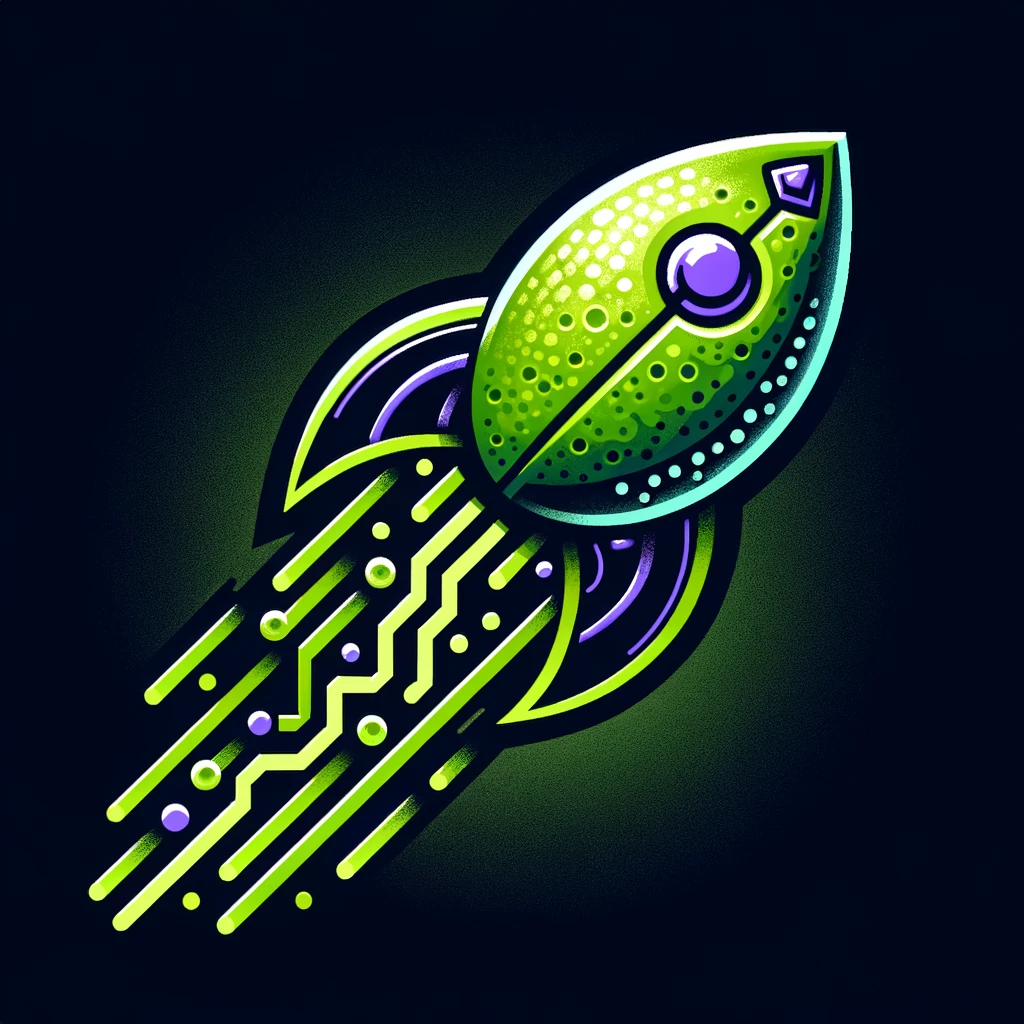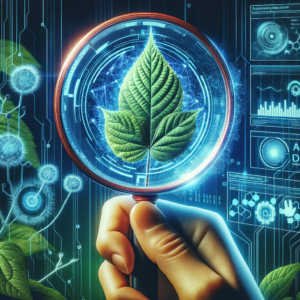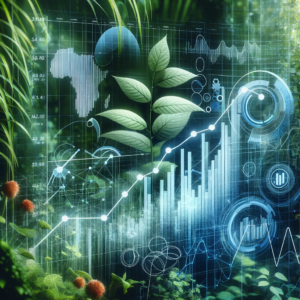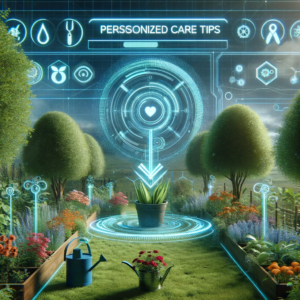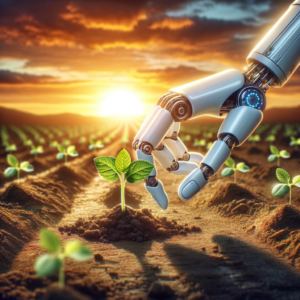Merging Petals & Pixels: The Intersection of Gardening & AI
Gardening, in its purest form, is a testament to the enduring bond between humanity and nature. Through the centuries, the act of planting, nurturing, and harvesting has provided sustenance, solace, and artistic expression. It’s an art form where patience meets reward, and every bloom or harvested fruit embodies a gardener’s dedication. Regardless of era or geography, the allure of the garden remains consistent, beckoning green thumbs and novices alike to partake in the symphony of soil, water, and sunlight.
However, as we’ve ventured further into the 21st century, a new player has emerged on the gardening stage: technology. What once was a field dominated by tactile sensations – the feel of the soil, the observation of a plant’s color – is now being enhanced with digital tools. From automated watering systems to gardening apps, technology has gracefully intertwined with nature, elevating the gardening experience to newfound heights.
Central to this technological renaissance in gardening is Artificial Intelligence. Its entrance into the verdant realms of gardens might seem unexpected, yet its potential impact is profound. With its ability to analyze vast amounts of data, predict outcomes based on intricate patterns, and provide real-time feedback, AI is becoming an indispensable companion for modern gardeners. As we venture further into this landscape, we’ll explore how this melding of organic and digital is not just improving garden yields, but fundamentally reshaping our understanding of gardening in the modern age.
Digital Diagnosis: AI’s Eye for Spotting Plant Diseases
Every gardener, whether novice or experienced, has encountered the sinking feeling of discovering a beloved plant under siege by an unknown disease. Historically, combatting such ailments was a challenge; accurate diagnosis depended heavily on experience, intuition, or at times, the costly advice of an expert. However, with the dawn of the digital age, a transformative tool has emerged for plant caregivers: AI-driven image recognition.
Modern AI technologies possess the incredible capability to analyze and recognize patterns from vast amounts of visual data. When applied to gardening, this means that a vast library of plant diseases, each with its unique set of symptoms, can be stored and referenced. With just a simple photograph of a discolored leaf or a wilting stem, AI algorithms leap into action, scanning their database to find a match.
This real-time diagnosis offers gardeners an immediacy that was previously unattainable. Instead of waiting days or even weeks for a professional opinion or researching through countless gardening books, the answer, accurate to a high degree, is provided almost instantaneously. This speed is not just a matter of convenience; in the world of plants, early detection can be the difference between the life and death of the affected flora.
Yet, the capabilities of AI in gardening extend beyond mere identification. Once a disease is detected, AI systems can then provide invaluable advice on tackling the issue. This could be a recommendation for a specific organic remedy, guidance on adjusting sunlight or watering conditions, or even suggesting physical barriers to prevent the spread of airborne pathogens.
Furthermore, as technology evolves, some AI platforms integrate predictive measures. By analyzing weather data, historical disease patterns, and other environmental factors, these systems can alert gardeners to potential disease risks before they manifest. This forward-thinking approach allows for preventive care, ensuring plants remain healthy and vibrant.
In the verdant world of gardening, AI stands as a testament to the harmonious melding of nature and technology. It offers a beacon of hope and a tool of empowerment, ensuring that gardens, whether they’re sprawling landscapes or humble windowsills, flourish under the diligent care of their human stewards, now armed with the might of artificial intelligence.
Eco-Friendly Hydration: AI’s Blueprint for Smart Watering Solutions
Water is the lifeblood of any garden, a crucial element that nourishes plants and ensures their healthy growth. Yet, determining the right amount of water, at the right time, has long been a delicate balancing act for gardeners. Water too little, and plants wither; water too much, and roots might rot. Enter the age of AI, where technology is simplifying this age-old challenge through smart watering systems, ensuring plants get just the right amount of hydration they need.
AI-driven irrigation is more than just automated sprinklers turning on and off. It’s about intelligent systems that leverage vast amounts of data to make informed decisions. By analyzing real-time weather forecasts, understanding the specific moisture needs of individual plant species, and even gauging the moisture content of the soil, AI provides a holistic approach to watering. Instead of relying on set timers or manual observations, gardens are now nurtured based on precise needs determined by algorithms.
The beauty of these AI-powered systems lies in their adaptability. For instance, if a rainy week is predicted, the system can adjust to reduce or even skip watering sessions, relying instead on nature’s provision. Conversely, during hotter days or unexpected dry spells, the AI can increase watering to ensure plants remain adequately hydrated. This dynamic approach is especially beneficial in regions with water restrictions or for gardeners keen on sustainability.
Conservation is another notable advantage. With water becoming an increasingly precious resource globally, efficient use in gardening is paramount. AI-driven irrigation not only ensures plants receive adequate water but does so in a manner that minimizes waste. The result is a reduced water footprint without compromising plant health.
Beyond conservation, healthier plants are a direct outcome of AI’s precision. By tailoring watering schedules to plants’ exact needs, the risk of common issues like root rot or dehydration diminishes. Plants flourish, displaying vibrant colors and robust growth, all thanks to the synergy of nature and machine.
In conclusion, smart watering systems epitomize the potential of integrating AI with gardening. They represent a future where technology serves nature, ensuring gardens not only survive but thrive, while simultaneously championing the cause of conservation.
Green Growth Algorithms: AI’s Predictive Power in Plant Growth
Every gardener dreams of flourishing plants, blossoming flowers, and bountiful yields. Yet, achieving such results requires understanding a myriad of factors that influence plant growth, from soil conditions to sunlight exposure. Historically, predicting plant growth was primarily based on anecdotal experiences and general guidelines. Today, however, with the integration of AI, a revolution is underway, offering detailed forecasts and actionable insights that promise optimized growth like never before.
Central to AI’s prowess in this realm is its ability to process vast volumes of data. By assimilating historical growth data of specific plants, current soil conditions, weather forecasts, and even data from similar environments elsewhere, AI can make informed predictions about how a plant is likely to grow in the coming days, weeks, or even months. This isn’t just about predicting the height or spread of a plant, but also understanding its potential flowering or fruiting cycles, potential pest vulnerabilities, and nutrient needs.
Such precise growth forecasting holds numerous advantages. For one, gardeners can plan better. Knowing when a particular plant is expected to flower or fruit can inform decisions about companion planting, pruning, or even organizing garden aesthetics. Additionally, with insights about potential challenges a plant might face, be it pests or nutrient deficiencies, preemptive actions can be taken to mitigate issues before they manifest.
But AI’s role doesn’t stop at mere predictions. It actively provides recommendations to bolster plant health and ensure optimal growth. By continuously monitoring environmental conditions, AI systems can suggest adjustments to watering schedules, recommend specific fertilizers or nutrients, or even provide guidance on repositioning plants for better sunlight exposure.
The true wonder of this AI-guided approach lies in its adaptability. As conditions change or as new data becomes available, the AI adjusts its recommendations, ensuring that advice remains current and relevant. This dynamic guidance means gardens are not just static entities but evolving ecosystems that adapt and thrive.
In essence, AI’s role in growth prediction and optimization is akin to having a personal gardening assistant, one that’s tirelessly dedicated, perpetually informed, and keenly attuned to every plant’s needs. As we harness this power, the promise of thriving gardens, optimized for health and beauty, becomes a tangible reality for every gardener.
Tailored Tending: AI’s Personal Touch in Garden Care
The art of gardening is deeply personal. Each gardener has a unique touch, a distinct style, and individual preferences that influence their green sanctuary. Additionally, every garden has its own set of characteristics – from the type of soil and ambient light conditions to the specific plants chosen. In such a diverse and dynamic environment, generic advice often falls short. Recognizing this complexity, AI has stepped in to provide personalized plant care recommendations, ensuring that advice is not only accurate but also uniquely tailored to individual gardens and their caretakers.
Utilizing sensors and a plethora of data points, AI systems can gain a comprehensive understanding of a garden’s environment. They analyze sunlight patterns, track soil moisture and pH levels, and even understand the specific needs of different plant species within the garden. By integrating all this information, AI doesn’t just offer general gardening tips; it delivers precise advice, customized for each garden’s unique ecosystem.
For instance, if a gardener prefers organic methodologies, the AI can suggest natural pest deterrents or organic fertilizers suitable for the specific plants in their garden. Likewise, for those dabbling in edible gardens, AI can recommend optimal planting cycles, ensuring a continuous supply of fresh produce throughout the seasons. Companion planting, a technique where specific plants are grown together for mutual benefits, can also be optimized. AI can suggest perfect pairings based on plant species, ensuring enhanced growth, pest deterrence, and even improved flavor profiles for edibles.
One of the standout features of AI-driven gardening solutions is their learning capability. As they continue to monitor and receive feedback from the gardener, these systems refine their recommendations. Over time, the advice becomes increasingly attuned to the gardener’s preferences and the garden’s evolving needs, fostering a symbiotic relationship between the AI, the garden, and its caretaker.
In conclusion, while gardening has always been a harmonious blend of science and art, the introduction of AI augments this balance, adding a layer of precision and customization. Through AI’s personalized plant care recommendations, gardeners are empowered to make informed decisions, nurturing gardens that not only thrive but also resonate deeply with their personal touch.
Virtual Verdure: Designing Dream Gardens with AI & VR
At the heart of every breathtaking garden lies a thoughtfully crafted design. A blueprint that considers the symphony of colors, the balance of light and shade, and the rhythm of varying plant heights. Traditional garden design was an art mastered over the years, often relying on intuition, experience, and a bit of trial and error. But now, with advancements in AI, a new era of garden design is dawning — one that combines the age-old wisdom of horticulture with cutting-edge technology.
Modern AI tools offer an innovative approach to garden design. With capabilities to analyze a plot’s dimensions, sunlight patterns, and soil conditions, these AI platforms can suggest optimal layouts tailored for each unique space. Want a garden that’s in full bloom year-round? AI can recommend a combination of plants that will ensure sequential blooming. Looking to create a peaceful shaded nook? The system can identify the best spots based on sun trajectories and suggest tree or shrub varieties that provide the desired canopy. Every element, from aesthetics to practicality, is considered, making garden planning both a science and an art.
Yet, while AI provides invaluable data and suggestions, visualizing the outcome has always posed a challenge. This is where the synergy of AI and virtual reality (VR) comes into play. Imagine donning a VR headset and walking through your future garden, experiencing the play of sunlight, the arrangement of plants, and even the progression of seasons. Such immersive experiences allow gardeners to make informed design choices, tweaking and adjusting the layout until it aligns perfectly with their vision.
Moreover, the potential applications of AI and VR in garden design extend beyond individual gardens. Landscape architects and city planners can leverage these technologies to design public spaces, parks, and green zones that are not only aesthetically pleasing but also sustainable and beneficial for the environment.
In essence, the fusion of AI with garden design is redefining the boundaries of what’s possible in horticulture. It provides a canvas where creativity meets technology, enabling gardeners to craft spaces that resonate with beauty, functionality, and personal touch. As we continue to harness this powerful synergy, gardens of the future promise to be masterpieces of design, seamlessly blending nature’s chaos with technological precision.
Future Flourish: Envisioning AI’s Green Thumb in Tomorrow’s Gardens
As we’ve journeyed through the myriad ways in which AI intersects with gardening, it’s clear that we’re standing at the cusp of a horticultural revolution. The age-old practices of gardening, enriched with millennia of human experience and wisdom, are now being amplified and enhanced by the precision, adaptability, and foresight that AI brings. It’s a melding of tradition with innovation, grounding us in the past while propelling us towards a future teeming with possibilities.
The gardens of tomorrow, sculpted with the aid of AI, promise to be spaces of both beauty and sustainability. Beyond just aesthetic appeal, they’ll be more resilient ecosystems, optimized for water conservation, disease resistance, and harmonious plant interactions. As AI systems become more advanced and attuned to individual preferences and local ecosystems, every patch of green, whether a sprawling estate or a humble balcony, can be a thriving, eco-friendly oasis.
But perhaps the most profound impact of AI lies in its ability to democratize expertise. No longer will advanced gardening techniques or insights be the exclusive domain of professionals or seasoned hobbyists. With AI tools becoming increasingly accessible, every individual, regardless of their gardening experience, will have the resources to cultivate their dream garden.
As we look ahead, it’s exciting to envision a world where gardens are not just places of respite but are also reflections of the harmonious union between nature and technology. In this blossoming future, AI stands as a testament to humanity’s ingenuity, demonstrating that when technology is wielded with care and respect for nature, it can lead to creations of profound beauty and significance.
